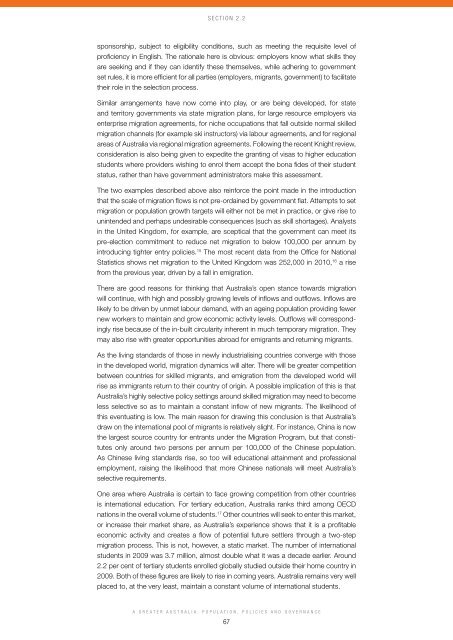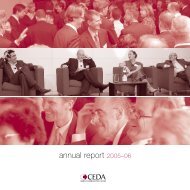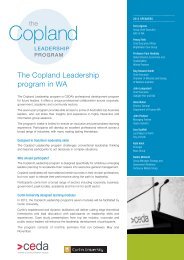A Greater Australia: Population, policies and governance - CEDA
A Greater Australia: Population, policies and governance - CEDA
A Greater Australia: Population, policies and governance - CEDA
- No tags were found...
You also want an ePaper? Increase the reach of your titles
YUMPU automatically turns print PDFs into web optimized ePapers that Google loves.
Section 2.2sponsorship, subject to eligibility conditions, such as meeting the requisite level ofproficiency in English. The rationale here is obvious: employers know what skills theyare seeking <strong>and</strong> if they can identify these themselves, while adhering to governmentset rules, it is more efficient for all parties (employers, migrants, government) to facilitatetheir role in the selection process.Similar arrangements have now come into play, or are being developed, for state<strong>and</strong> territory governments via state migration plans, for large resource employers viaenterprise migration agreements, for niche occupations that fall outside normal skilledmigration channels (for example ski instructors) via labour agreements, <strong>and</strong> for regionalareas of <strong>Australia</strong> via regional migration agreements. Following the recent Knight review,consideration is also being given to expedite the granting of visas to higher educationstudents where providers wishing to enrol them accept the bona fides of their studentstatus, rather than have government administrators make this assessment.The two examples described above also reinforce the point made in the introductionthat the scale of migration flows is not pre-ordained by government fiat. Attempts to setmigration or population growth targets will either not be met in practice, or give rise tounintended <strong>and</strong> perhaps undesirable consequences (such as skill shortages). Analystsin the United Kingdom, for example, are sceptical that the government can meet itspre-election commitment to reduce net migration to below 100,000 per annum byintroducing tighter entry <strong>policies</strong>. 15 The most recent data from the Office for NationalStatistics shows net migration to the United Kingdom was 252,000 in 2010, 16 a risefrom the previous year, driven by a fall in emigration.There are good reasons for thinking that <strong>Australia</strong>’s open stance towards migrationwill continue, with high <strong>and</strong> possibly growing levels of inflows <strong>and</strong> outflows. Inflows arelikely to be driven by unmet labour dem<strong>and</strong>, with an ageing population providing fewernew workers to maintain <strong>and</strong> grow economic activity levels. Outflows will correspondinglyrise because of the in-built circularity inherent in much temporary migration. Theymay also rise with greater opportunities abroad for emigrants <strong>and</strong> returning migrants.As the living st<strong>and</strong>ards of those in newly industrialising countries converge with thosein the developed world, migration dynamics will alter. There will be greater competitionbetween countries for skilled migrants, <strong>and</strong> emigration from the developed world willrise as immigrants return to their country of origin. A possible implication of this is that<strong>Australia</strong>’s highly selective policy settings around skilled migration may need to becomeless selective so as to maintain a constant inflow of new migrants. The likelihood ofthis eventuating is low. The main reason for drawing this conclusion is that <strong>Australia</strong>’sdraw on the international pool of migrants is relatively slight. For instance, China is nowthe largest source country for entrants under the Migration Program, but that constitutesonly around two persons per annum per 100,000 of the Chinese population.As Chinese living st<strong>and</strong>ards rise, so too will educational attainment <strong>and</strong> professionalemployment, raising the likelihood that more Chinese nationals will meet <strong>Australia</strong>’sselective requirements.One area where <strong>Australia</strong> is certain to face growing competition from other countriesis international education. For tertiary education, <strong>Australia</strong> ranks third among OECDnations in the overall volume of students. 17 Other countries will seek to enter this market,or increase their market share, as <strong>Australia</strong>’s experience shows that it is a profitableeconomic activity <strong>and</strong> creates a flow of potential future settlers through a two-stepmigration process. This is not, however, a static market. The number of internationalstudents in 2009 was 3.7 million, almost double what it was a decade earlier. Around2.2 per cent of tertiary students enrolled globally studied outside their home country in2009. Both of these figures are likely to rise in coming years. <strong>Australia</strong> remains very wellplaced to, at the very least, maintain a constant volume of international students.A <strong>Greater</strong> <strong>Australia</strong>: <strong>Population</strong>, Policies <strong>and</strong> Governance67





